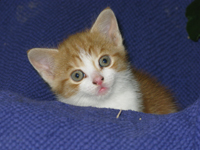|
Cat Behaviour
and Potential Problems |
|
The most common behaviour problems treated in cats
[1] are:
-
house soiling, including
spraying
-
aggression (towards people or
other cats)
-
compulsive or repetitive
behaviour
-
separation anxiety
-
vocalisation (howling and yowling)
-
wool eating ("pica")
-
fearful behaviour
Behaviour such as furniture scratching, problems eating or
anxiety-related behaviour such as hiding or fur pulling may also
cause concern for owners
[2].
|

|
|

 |
Common Causes of Cat Behaviour Problems
Although they often appear solitary in nature, cats are in fact
social animals. However, they are very choosy about who they form
social groups with; their groups are formed according to cats' rules
and are not influenced by the factors we might consider relevant,
such as living in the same house!
Behaviour problems in cats frequently arise in cats who happen to
share a house but have not formed a social group together. The
enforced close proximity can lead to aggression and fights, or more
subtle anxiety or stress-related problems.
In other cases aggression or fear-related behaviours develop as a result of inadequate
socialisation as a kitten, or from a
previous bad experience. A cat's natural response to threat is to
escape to a safe place, often at height. A frightened cat will
usually only fight if cornered, but if the cat has learned from
previous experience that it is unable to escape it may launch an "unprovoked" attack the next time
it feels threatened. If this fear is directed at people, a serious behaviour problem causing potential injuries
can develop.
Other behaviours e.g. biting or scratching may be misdirected play,
while "spraying" in the house or furniture scratching are
features of natural cat behaviour, which cause problems because they
are inappropriate in the domestic setting.
|
|
Treating Cat Behaviour Problems
Using gentle, reward-based methods, many undesired behaviours can be
reduced or resolved.
In cases where anxiety, phobia or aggression is a symptom of an
underlying fear, a behavioural modification technique called
"de-sensitisation and counter-conditioning" can reduce the
fear and allow the cat to learn more appropriate responses and
behaviour.
If your cat is exhibiting any behaviour that is giving you cause for
concern, please see your vet to rule out medical causes and to
request a behavioural
referral, then
contact me to make an appointment.
|
 |
|
 |
Prevention of Cat Behaviour Problems
As with all animals, socialisation
is vital to the prevention of behaviour problems later in life as it
teaches the cat how to interact appropriately with the people and
animals in its life, and gently introduces it to the sights, sounds
and smells it will encounter later in life, preventing fear from
developing later on. The socialisation period for cats occurs
between the ages of approximately 2-9 weeks, during which time
handling by different people improves the cat's later relationship
with humans, while exposure to objects, events and other animals
teaches the kitten how to relate to these things.
While the socialisation period is the optimum time for introducing a
kitten to the world, learning continues throughout life, so even a
poorly socialised cat can be rehabilitated with behaviour
counselling. It is never too late to help your pet, and I'm always
happy to hear from you and to talk about any concerns you have, so
please don't hesitate to
contact
me. |
|
[1]
Halip JW, Vaillancourt JP, Luescher UA
1998 A descriptive study of 189 cats engaging in
inappropriate elimination behaviours. Feline Practice 28
(4): 18-21.
[2]
Heidenberger E 1997 Housing conditions and behavioural
problems of indoor cats as assessed by their owners. Applied
Animal Behavioral Science 2:345-364. |
|
